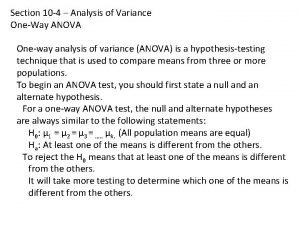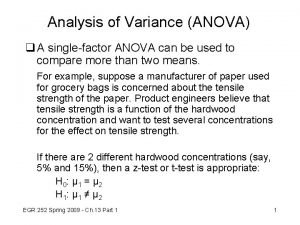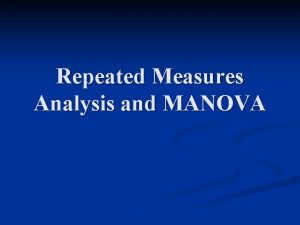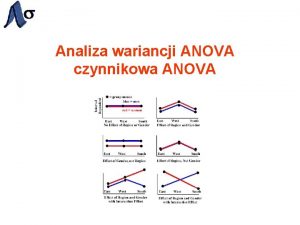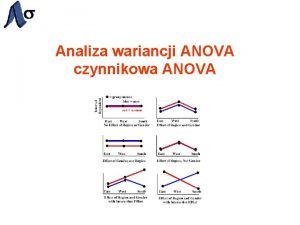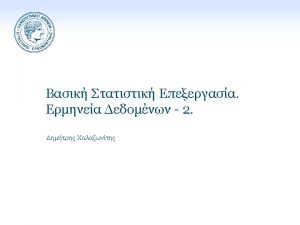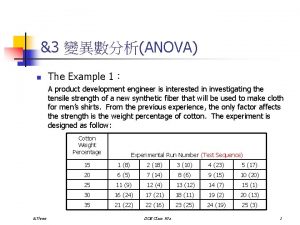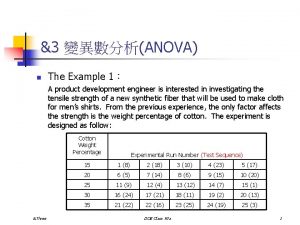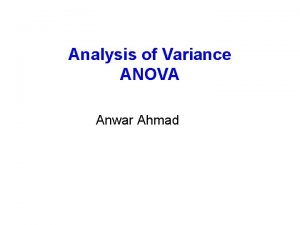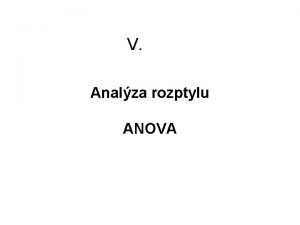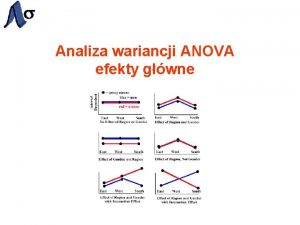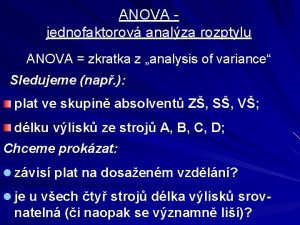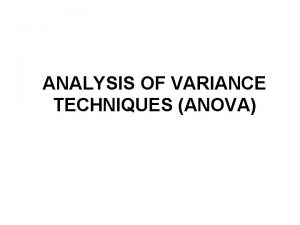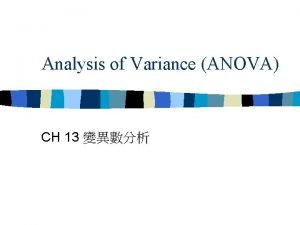3 ANOVA n The Example 1 A product








































- Slides: 40

&3 變異數分析(ANOVA) n The Example 1: A product development engineer is interested in investigating the tensile strength of a new synthetic fiber that will be used to make cloth for men’s shirts. From the previous experience, the only factor affects the strength is the weight percentage of cotton. The experiment is designed as follow: Cotton Weight Percentage &Three Experimental Run Number (Test Sequence) 15 1 (8) 2 (18) 3 (10) 4 (23) 5 (17) 20 6 (5) 7 (14) 8 (6) 9 (15) 10 (20) 25 11 (9) 12 (4) 13 (12) 14 (7) 15 (1) 30 16 (24) 17 (21) 18 (11) 19 (2) 20 (13) 35 21 (22) 22 (16) 23 (25) 24 (19) 25 (3) DOE Class 90 a 1

實驗結果 &Three DOE Class 90 a 2

統計圖表分析 &Three DOE Class 90 a 3

單因子變異數分析 n The Model n Means Model n Effects Model n 其中: n n n &Three yij為第(ij)個觀測值 m為整體平均數 ti為第i個因子水準效應 eij為隨機誤差~N(0, s 2) Fixed Effects Model Vs. Random Effects Model DOE Class 90 a 4

其中: &Three DOE Class 90 a 5


ANOVA表格 Treatment (Treatment) &Three DOE Class 90 a 7

n 其中:a 為因子之水準數 n 為每一水準之資料個數(複製次數) Treatment =0 Treatment 所以 Treatment 又 Treatment 且 &Three DOE Class 90 a Treatment 8


Example 1:布料強度之研究 &Three DOE Class 90 a 10

&Three DOE Class 90 a 11


模式參數之估計 &Three DOE Class 90 a 13

&Three DOE Class 90 a 14

Unbalanced Data n n If the number of observations for each treatment is different (unbalanced data), then Two reasons for choosing a balanced design n n &Three Test statistics is relatively insensitive to small departures from the assumption of equal variances. The power of the test is maximized. DOE Class 90 a 15

Example 2:紙張強度之研究 &Three DOE Class 90 a 16

殘值分析 (Residual Analysis) n &Three 確定殘差(Residual)來自於自然變異N(0, s 2) DOE Class 90 a 17

Residual Analysis I – Normality Plot n n Standardized Residuals If |dij| > 3, a possible outlier. &Three DOE Class 90 a 18

Residual Analysis II n n Residual Vs. Factor Levels (Treatment) => Equal Variances Residual Vs. Time => Independence &Three DOE Class 90 a 19

Residual Analysis III n &Three Residual Vs. Estimates=> Equal Variances DOE Class 90 a 20

資料轉換(Data Transformation) n 若Residual Vs. Estimates之圖有任何異常時,應考慮做資 n 料轉換。 常用之資料轉換公式: n &Three n Poisson Data => Square Root Transformation n Lognomal Data => Logarithmic Transformation n Binomial Data => Arcsin Transformation Empirical Selection of a Transformation (pp. 83 -86) DOE Class 90 a 21

Tests for Equality of Variance n Bartllet’s Test n Modified Levene Test n &Three (pp. 81) (pp. 82) Used when normality assumption is possibly violated. DOE Class 90 a 22

Comparisons Among Treatment Means (pp. 86 -104) n n n Graphical Comparisons of Means Constrasts Orthogonal Constrasts Scheffe’s Method (Comparing all Constrasts) Comparing Pairs of Treatment Means n n n &Three Turkey’s Test Fisher’s LSD Method Duncan’s Multiple Range Test Newman-Keuls Test Dunnett’s Procedure (Comparing to a constant) DOE Class 90 a 23

Sample Computer output (pp. 105) n C. V. = (s. d. / mean) * 100% n PRESS: Predict Error Sum of Square n R-Squared = SSTreatments / SST n Adj R-Squared =1 -[SSE/(N-a)]/[SST/(N-1)] n Pred R-Squared = (SST-PRESS)/ SST n Adeq Precision must greater than 4. n 分析程序 &Three DOE Class 90 a 24

樣本大小 (pp. 107~110) n Operating Characteristic Curves n Specifying a Standard Deviation Increase n Confidence Interval Estimation Method &Three DOE Class 90 a 25

Miscellaneous Topics (pp. 110~119) n Discovering Dispersion Effects n The Regression Approach to ANOVA n Nonparametric Methods in ANOVA n n &Three Kruskal-Wallis Test Rank Transformation DOE Class 90 a 26


Example n 計算此因子對製程整體變異之重要性: m Rando Select &Three DOE Class 90 a 28


&Three DOE Class 90 a 30



Example: (續) &Three DOE Class 90 a 33



&Three DOE Class 90 a 36

ANOVA表 – Latin Square Design &Three DOE Class 90 a 37

&Three DOE Class 90 a 38

&Three DOE Class 90 a 39

常見的拉丁方格設計 n &Three 需要三個區隔方式時,可使用Graeco-Latin Square Design。(略) DOE Class 90 a 40
 Perbedaan one way two way anova
Perbedaan one way two way anova One way anova vs two way anova
One way anova vs two way anova Contoh soal analisis varians
Contoh soal analisis varians 2 way anova example
2 way anova example One way anova null hypothesis
One way anova null hypothesis Example anova table
Example anova table Subject id example
Subject id example Hình ảnh bộ gõ cơ thể búng tay
Hình ảnh bộ gõ cơ thể búng tay Slidetodoc
Slidetodoc Bổ thể
Bổ thể Tỉ lệ cơ thể trẻ em
Tỉ lệ cơ thể trẻ em Voi kéo gỗ như thế nào
Voi kéo gỗ như thế nào Chụp phim tư thế worms-breton
Chụp phim tư thế worms-breton Chúa yêu trần thế
Chúa yêu trần thế Môn thể thao bắt đầu bằng từ đua
Môn thể thao bắt đầu bằng từ đua Thế nào là hệ số cao nhất
Thế nào là hệ số cao nhất Các châu lục và đại dương trên thế giới
Các châu lục và đại dương trên thế giới Công của trọng lực
Công của trọng lực Trời xanh đây là của chúng ta thể thơ
Trời xanh đây là của chúng ta thể thơ Mật thư anh em như thể tay chân
Mật thư anh em như thể tay chân Làm thế nào để 102-1=99
Làm thế nào để 102-1=99 Phản ứng thế ankan
Phản ứng thế ankan Các châu lục và đại dương trên thế giới
Các châu lục và đại dương trên thế giới Thể thơ truyền thống
Thể thơ truyền thống Quá trình desamine hóa có thể tạo ra
Quá trình desamine hóa có thể tạo ra Một số thể thơ truyền thống
Một số thể thơ truyền thống Cái miệng nó xinh thế
Cái miệng nó xinh thế Vẽ hình chiếu vuông góc của vật thể sau
Vẽ hình chiếu vuông góc của vật thể sau Nguyên nhân của sự mỏi cơ sinh 8
Nguyên nhân của sự mỏi cơ sinh 8 đặc điểm cơ thể của người tối cổ
đặc điểm cơ thể của người tối cổ V cc
V cc Vẽ hình chiếu đứng bằng cạnh của vật thể
Vẽ hình chiếu đứng bằng cạnh của vật thể Tia chieu sa te
Tia chieu sa te Thẻ vin
Thẻ vin đại từ thay thế
đại từ thay thế điện thế nghỉ
điện thế nghỉ Tư thế ngồi viết
Tư thế ngồi viết Diễn thế sinh thái là
Diễn thế sinh thái là Các loại đột biến cấu trúc nhiễm sắc thể
Các loại đột biến cấu trúc nhiễm sắc thể Số nguyên tố là số gì
Số nguyên tố là số gì Tư thế ngồi viết
Tư thế ngồi viết



